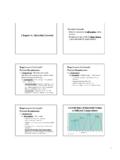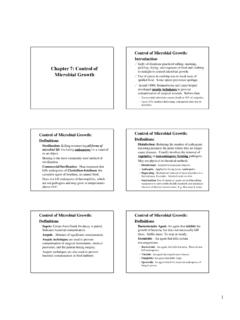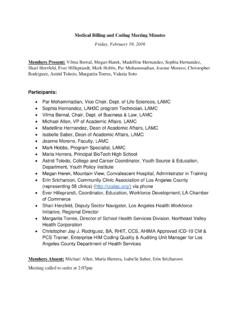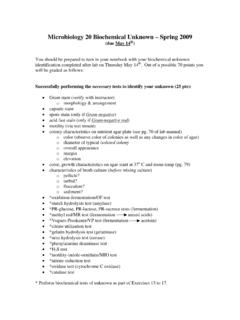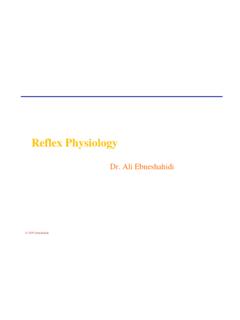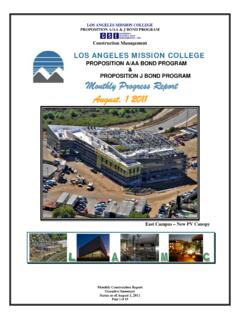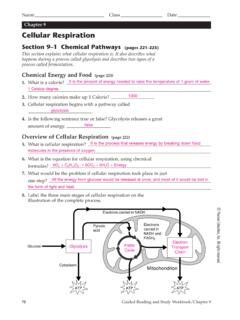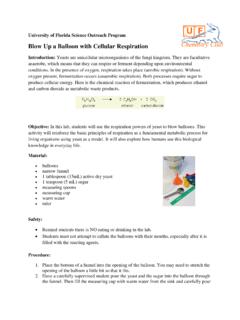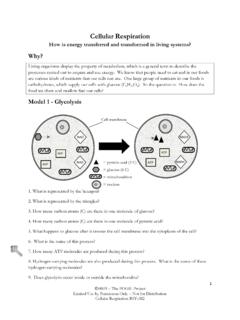Transcription of LAB 6 Fermentation & Cellular Respiration
1 LAB 6 Fermentation & Cellular Respiration INTRODUCTION The cells of all living organisms require energy to keep themselves alive and fulfilling their roles. Where does this energy come from? The answer is energy released from molecules of the nucleotide adenosine triphosphate or ATP. As you can see from the diagram above, the hydrolysis of ATP to ADP (adenosine diphosphate) and inorganic phosphate (Pi) is exergonic and thus releases energy which cells can use to do any number of things. Once hydrolyzed, ATP can be regenerated from ADP and Pi, though this is endergonic and thus requires energy. The energy needed to regenerate ATP is obtained from food , whatever that may be.
2 The food we eat is first digested by enzymes as you learned in the previous lab. Once the polymers in your food ( , polysaccharides, triglycerides, protein) have been broken down by enzymes into monomers ( , monosaccharides such as glucose, fatty acids, amino acids), they enter the blood circulation and are delivered to the cells of the body. Within cells, the processes of Fermentation and Cellular Respiration will further catabolize (break down) these molecules, harvesting the energy they contain for the synthesis of ATP. Let us now take a brief look at Fermentation and Cellular Respiration to see how each process produces ATP using energy released from molecules of glucose.
3 Keep in mind that, although we are focusing on glucose, other molecules such as fatty acids can be used for the same purpose, though in slightly different ways. Part 1: Fermentation To produce ATP from glucose, whether by Fermentation or Cellular Respiration , cells must first partially break it down by glycolysis ( sugar separation ). The enzymes involved in glycolysis are located in the cell cytoplasm and sequentially break down each 6-carbon molecule of glucose to two 3-carbon molecules of pyruvate. In the process, enough energy is extracted to produce 2 molecules of ATP. glucose (6-carbons) 2 pyruvate (3-carbons) 2 ADP + 2 Pi 2 ATP In conjunction with glycolysis, cells will carry out Fermentation if there is no oxygen (O2) available.
4 When you overexert yourself for example, your muscles do not receive enough oxygen and temporarily ferment glucose. In another familiar example, yeast will ferment when placed in an enclosed environment with a source of carbohydrate such as grapes (for making wine) or hops and barley (for making beer). Interestingly, Fermentation does not produce any additional ATP. What it does do is regenerate an important molecule needed for a particular step in glycolysis. This molecule is the electron carrier NAD+, which if depleted will bring a halt to glycolysis and ATP production, resulting in cell death. Fermentation therefore contributes to ATP production indirectly by allowing glycolysis, and the production of 2 ATP per glucose, to continue unhindered.
5 2 NAD+ 2 NADH 2 NAD+ glucose 2 pyruvate 2 Fermentation products 2 ADP + 2 Pi 2 ATP Glycolysis Fermentation As shown above, NAD+, an empty electron carrier, is converted to NADH, a full electron carrier (the electrons being carried are associated with the hydrogen atom) during glycolysis. Fermentation is simply one or more biochemical steps that transfer the H in NADH and an extra electron to a molecule of pyruvate. As a result, NADH is restored to NAD+, which is needed for glycolysis, and pyruvate is converted to a Fermentation product which can be a variety of things depending on the organism.
6 Animals, including human beings, produce lactic acid when their cells ferment. In organisms from other kingdoms the Fermentation products can be quite different. Some bacterial species produce acetic acid (vinegar) when they ferment, whereas others produce acetone (the main ingredient in nail polish) or other organic molecules. In the Kingdom Fungi, single-celled yeasts energy 2H- 2H- when fermenting will produce CO2 and ethanol instead. This process, known as alcohol Fermentation , is the basis for beer and wine production. Regardless of the Fermentation products, the purpose of Fermentation is always the same to regenerate NAD+ so that glycolysis can continue to produce 2 ATP per glucose without interruption.
7 In the following exercise you will investigate alcohol Fermentation in yeast under different conditions and measure the production of one Fermentation product CO2. Exercise 1 Observing and Measuring Alcohol Fermentation in Yeast 1. You will use the following table to mix the proper amounts of water, yeast solution and corn syrup (a source of sugar) in small beakers. Be sure to add the yeast last. This will allow the reactions to begin at approximately the same time. Before you begin, review the experiment, write your hypothesis on your worksheet, and identify the independent and dependent variables as well as the control.
8 Tube #1 Tube #2 Tube #3 Water 8 ml 6 ml 4 ml Yeast 0 ml 2 ml 4 ml Corn syrup 4 ml 4 ml 4 ml TOTAL 12 ml 12 ml 12 ml 1. Once complete, transfer each mixture to a labeled saccharometer (do not overfill), then gently tilt until no air is trapped inside the top of the tube. At this point you will begin the timing of your experiment (record on your worksheet). 2. At 5 minute intervals, use the graduations on the side of the saccharometer to read the volume of gas collected in ml for a total of 30 minutes. 3. Record the data on your worksheet, graph the data, and answer any associated questions. Part 2: Cellular Respiration While 2 ATP per glucose molecule is clearly better than nothing, it is not nearly enough to meet the energy needs of complex multicellular organisms such as plants and animals.
9 To get the maximum ATP yield from molecules of glucose requires Cellular Respiration , which and produce up to 36 ATP per glucose molecule. In aerobic organisms, Cellular Respiration requires O2 (which is why we breathe!), hence the term aerobic Respiration . saccharometer The overall process of Cellular Respiration can be summarized in the following equation: glucose oxygen carbon dioxide water C6H12O6 + 6 O2 6 CO2 + 6 H2O 36 ADP + 36 Pi 36 ATP In eukaryotic cells, Cellular Respiration begins with glycolysis in the cytoplasm and continues in the mitochondria as outlined below: The Citric Acid Cycle This is a biochemical pathway involved in breaking pyruvate down to CO2.
10 In the process, energy rich electrons in hydrogen atoms are transferred to NAD+ and FAD producing NADH and FADH2. In addition, 2 ATP per original glucose are also produced. Oxidative Phosphorylation This is the process by which the remaining 32 ATP molecules are produced involving two distinct stages: Electron Transport - electrons gathered by NADH and FADH2 during glycolysis and the citric acid cycle are used to produce an H+ gradient within mitochondria in a process that requires O2 Chemiosmosis the H+ gradient produced by electron transport provides energy for ATP synthase to make 32 ATP per original glucose The importance of O2 for Cellular Respiration cannot be overemphasized.
